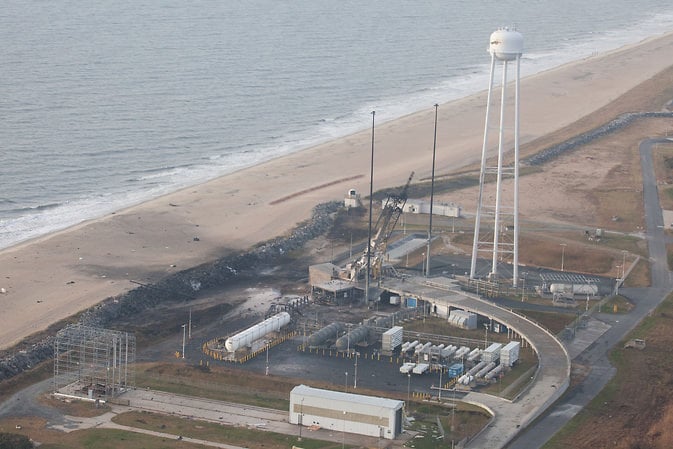NASA released images of the Mid-Atlantic Regional Spaceport at NASA's Wallops Flight Facility in Virginia following the catastrophic failure of Orbital Science's Antares rocket shortly after liftoff on Tuesday, Oct. 28. Visible is damage to the transporter erector launcher and lightning suppression rods, as well as debris around the pad. But given the spectacular secondary explosion when the rocket fell back to the pad, the damage – as viewed from the air – looks relatively minor.
[caption id="attachment_115837" align="aligncenter" width="580"]
Another aerial view of the Wallops Island launch facilities taken by the Wallops Incident Response Team Wednesday, Oct. 29, 2014, following the failed launch attempt of Orbital Science Corp.'s Antares rocket Oct. 28, Wallops Island, VA. Photo Credit: (NASA/Terry Zaperach)[/caption]
NASA and Orbital have begun and initial assessment of the accident, but they said it will "take many more weeks to further understand and analyze the full extent of the effects of the event."
NASA added that a number of support buildings in the immediate area have broken windows and imploded doors. What suffered the most damage were buildings nearest to pad 0A, where the launch took place, as well as a sounding rocket launcher adjacent to pad 0A.
"I want to praise the launch team, range safety, all of our emergency responders and those who provided mutual aid and support on a highly-professional response that ensured the safety of our most important resource -- our people," said Bill Wrobel, Wallops director. "In the coming days and weeks ahead, we'll continue to assess the damage on the island and begin the process of moving forward to restore our space launch capabilities. There's no doubt in my mind that we will rebound stronger than ever."
NASA also said that environmental effects of the launch failure were largely contained within the southern third of Wallops Island, in the area immediately adjacent to the pad. Air sample were taken in the area and of nearby Chincoteague Island, and no hazardous substances were detected at the sampled locations.
You can see more imagery at
NASA's Flickr page.
Universe Today's Ken Kremer was interviewed for NBC News, and you can view the feature below:
Source:
NASA
 Universe Today
Universe Today
